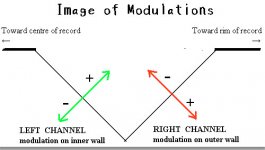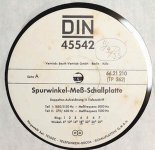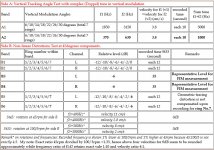A stylus riding up one groove wall would do exactly this: the motion vector for one channel being unaffected. And strictly this is mistracing, rather than geometric error. Such hairs are worth splitting, because they have different causal mechanisms, and riding a groove wall might readily be related by mechanics with friction, in principle..........That's probably the most important reason why I called it weird.
As you can see in posting #459 it occurs at this changed VTA setting only in one of the two channels.
The other channel is still behaving perfectly.
Yes, sensitivity varies from stylus to stylus IME. In fine line styli there seems far more likely to be a 3D sweet spot where all 3 axis need to be set well and VTA can be pretty sensitive.I already experimented with the lateral angle with no change, and the Azimuth also seems to be perfectly adjusted.
The opposite case in principle is the spherical, where stylus attitude shouldn't matter in terms of stylus-groove presentation. Leaving only geometric error, which is small in the scheme of things. Thesis is this is why a well manufactured well polished spherical can perform surprisingly well: it's tolerant of attitude misalignment in terms of the stylus-groove presentation angle. An averagely aligned spherical might well out-trace and out track an averagely aligned fine line stylus, if it has lower friction - only outperforming it with careful 3D alignment. I think this rings true and makes sense, perhaps ties quite a few loose ends too.
LD
Yes - just as a test! There goes another test record............;-)If this is correct then we should be able to test by wet playing.....(..).... Small differences in VTA should then make little or no difference?
LD
I may have realised the answer to my own question. I believe that the strain gauge carts track at somewhat higher VTF than the winfield, so even though the shibata is fatter any alignment inaccuracy will show up more due to the increased contact pressure (assuming the friction model is the correct one).
If this is correct then we should be able to test by wet playing and adjusting VTF? Small differences in VTA should then make little or no difference?
Likely the case and to answer your question I have two strain gauges in use, quite different from one another.
The first mounted on the Schick is an EPC-465C I typically track at 4.3 - 4.5gms, Panasonic recommends at least 4gms, and I have confirmed egregious mis-tracking occurs at 4gms and below, starting subtly on high amplitude HF and getting more pronounced as you drop just below 4gms. I suspect performance improves further as you approach 5gms. I surmise that the compliance already ridiculously low in this cartridge has only decreased over time.. There are moments where it is sublime in a way that nothing I have ever owned matched, and other times where, umm, it's definitely not..
The second is an EPC-451 which Panasonic claims will track well between 2 - 3gms, and which I find is acceptably happy at 2.7gms, and this is mounted on the Souther.
Note that the Windfeld tracks in the same force range as the 451, I typically run it at around 2.5 - 2.7gms.
I am now running Panasonic OEM shibata styli on both strain gauges. I have learned a bit about using them effectively.
Anyone know a simple way to calculate effective mass of an arm using known quantities like distance to pivot and masses on both sides relative to pivot points. Spread sheet maybe? I look at the calculations involved and my eyes just glaze over lol...
Yes, that's definitely the convention as set out in NAB recording specs 1964. Stylus motion parallel to the plane of the inner wall encodes the right channel.Thus your incorrect VTA seems to be doing something bad to the reading of the outside wall.
So a stylus mistracing/mistracking by riding up the inner groove wall incurs errors in the right channel. It's common for mistracking/mistracing to happen on the right channel preferentially. But when all is optimal it should be balanced.
LD
I mean a fine line stylus can need careful alignment to outperform a well made spherical.........whichever achieves better stylus-groove presentation friction might well be the audibly better, all other things being equal. I venture.Thesis is this is why a well manufactured well polished spherical can perform surprisingly well: it's tolerant of attitude misalignment in terms of the stylus-groove presentation angle. An averagely aligned spherical might well out-trace and out track an averagely aligned fine line stylus, if it has lower friction - only outperforming it with careful 3D alignment....
LD
Thanks, that's what I found also.The Left channel is on the inside wall of the groove, toward the label. Thus your incorrect VTA seems to be doing something bad to the reading of the outside wall.
In the cable spaghetti I had interchanged L and R to my sound card, so in fact it is the L channel, being the inside wall of the groove, that is causing trouble with an incorrect VTA setting.
Hans
Attachments
While searching the Internet, I came across this very intersting LP from Beuth, pressed by Teldec.
On Side A it has dual tone recordings cut with VTA's from 6 to 20 degrees in 4 degrees steps. That would be nice as a feature on the envisaged Test LP.
I wonder if anybody on this forum has acces to this very LP to produce .wav files with various types of needle tips.
Without altering anything to the TT setup, it could answer many questions.
Hans
On Side A it has dual tone recordings cut with VTA's from 6 to 20 degrees in 4 degrees steps. That would be nice as a feature on the envisaged Test LP.
I wonder if anybody on this forum has acces to this very LP to produce .wav files with various types of needle tips.
Without altering anything to the TT setup, it could answer many questions.
Hans
Attachments
Yes, that's definitely the convention as set out in NAB recording specs 1964. Stylus motion parallel to the plane of the inner wall encodes the right channel.
That is in accordance with the drawing in posting #487.
I suppose that "right channel" is a typo and should be "left channel".So a stylus mistracing/mistracking by riding up the inner groove wall incurs errors in the right channel. It's common for mistracking/mistracing to happen on the right channel preferentially. But when all is optimal it should be balanced.LD
Hans
Yes - just as a test! There goes another test record............;-)
LD
Hopefully we'll have plenty.
The scope for confusion has counfounded people for decades, so why not us too ?I suppose that "right channel" is a typo and should be "left channel".
The outer groove wall contains right side channel modulation. So errors which cause the stylus to ride up the inner groove wall affect the right side channel.
It's normal, in an offset arm, for mistracking/mistracing to favour the right side channel first because of the line of applied force. In your case Hans, with a linear arm, this preference isn't necessarily the same and either is possible.
I shouldn't worry, the principle is the thing at issue here rather than absolute assignments.
LD
Thanks, that's what I found also.
In the cable spaghetti I had interchanged L and R to my sound card, so in fact it is the L channel, being the inside wall of the groove, that is causing trouble with an incorrect VTA setting.
Hans
I understand you are using linear trackers, I have two Souther LTAs, and usually when I start to hear audible distortion on the left channel (I am not measuring) it is because there is excessive friction between the sled and the rails and contact with the groove inner wall is being lost. Cleaning the quartz rails and bearings usually fixes that problem.
I have not established a strong relationship to VTA and audible distortion (perhaps it is too subtle) on just the left channel. In the case of both the Schick and Souther when VTA is off it manifests in a change in tonal balance (stridency) and a rapid and audible increase in distortion on both channels. (This is true of both the line contact equipped Windfeld which it should be said is not suitable for use on the Souther, and the shibata equipped strain gauges on either arm.)
This is what I heard relating to the event Scott mentioned at my place on Saturday.
Hi Kevin,I understand you are using linear trackers, I have two Souther LTAs, and usually when I start to hear audible distortion on the left channel (I am not measuring) it is because there is excessive friction between the sled and the rails and contact with the groove inner wall is being lost. Cleaning the quartz rails and bearings usually fixes that problem.
I have not established a strong relationship to VTA and audible distortion (perhaps it is too subtle) on just the left channel. In the case of both the Schick and Souther when VTA is off it manifests in a change in tonal balance (stridency) and a rapid and audible increase in distortion on both channels. (This is true of both the line contact equipped Windfeld which it should be said is not suitable for use on the Souther, and the shibata equipped strain gauges on either arm.)
This is what I heard relating to the event Scott mentioned at my place on Saturday.
It's correct that I have a tangential arm. In my case the arm is moved by a small DC electro motor, where friction really plays no role.
I have never tried the audible effects in relation to VTA. I have simply adjusted everything as correct as possible and that was it.
However from a sheer technical point of view, I was challenged to investigate the matter into more detail.
And to my surprise I really found some measurable artefacts, like smearing of the frequency bands and a 90 degrees phase shift of the FM products in the left channel with a changed VTA.
This does not automatically mean that this will also be audible, but I feel no urge to find out, I'm very happy the way everything sounds.
Hans
When I change things (easily as much as we did Saturday) I hear virtually nothing. Plenty of pressure to go down the rabbit hole and start accumulating second hand stuff and start fussing myself. I might be better off not going there, what next glowing SET's?
One could argue you have already been there but escaped! I'm well down it and have now accumulated more projects than I can possibly ever complete.
One could argue you have already been there but escaped! I'm well down it and have now accumulated more projects than I can possibly ever complete.
No, no, they want to throw me right back in.
Slightly OT but with the hope of becoming on topic I've been mulling about extreme stylus profiles and how they wear again. LD in his audiokarma alter-ego from a few years back confirmed what I had been thinking, which was that however large the major radius a new stylus will still effectively be a point contact as vinyl is not as squishy as some might think. That's when new, but over time will that large major radius wear to a long flat, or retain it's curvature, and will that flat come before you sink to the bottom of the groove.
We need to compare low and high mileage samples (which I think we might be able to do) and get some nice pictures. If the wear occurs, then we should be able to measure something? If VTF remains constant and the contact patch increases, then noise (for an optimally aligned cartridge) should go down. But conversely any misalignment will create more noise as the contact patch lengthens.
I'm starting to wonder about this ability of DMM to synthetically change cutter angle and if that could be used to 'warble' the angle to bring the mountain to $DEITY. If you can change the angle over +/-5 degrees on a test track then the computer can potentially tell you how far out you are if the test signal is right.
It's late...I'm confused again
- Home
- Source & Line
- Analogue Source
- Test LP group buy


